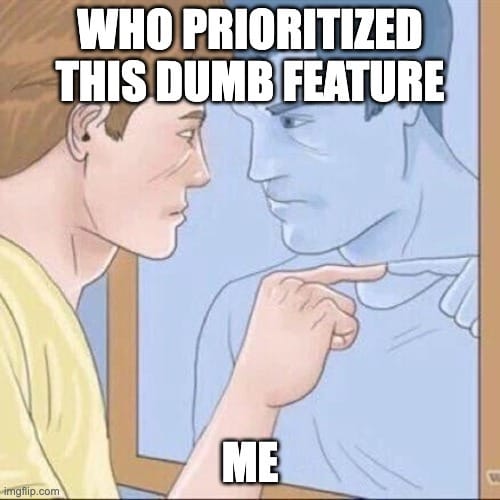ProductFTW #5: Being the First Product Manager Part II
Remember that first week on the job? Remember getting blasted by that firehose of information and the overwhelming feeling that you might never get a handle on things? Well, get used to that feeling- it's part of the fun!
Remember that first week on the job? Remember getting blasted by that firehose of information and the overwhelming feeling that you might never get a handle on things? Well, get used to that feeling–it’s part of the fun! During your first month, you put together a rough strategy, took a stab at a roadmap, and introduced some light processes. Now’s not the time to rest, though–things are just getting started.
In Part 2 of Being the First Product Manager, we identify what to focus on after that first month and how to use continuous evaluation to make smart decisions to maximize your success as the OG PM. Let’s get out the raincoat and dive in.

After the first month
Alright. You’re 30 days in and getting the hang of things. You know your customers, the value your product provides, and the short to medium-term focus of the company. You’re vibing with the team, you have several new features lined up, and you know how you’re going to measure your success, right? No? Well, don’t stress yet- this shit is hard. If you are, in fact, crushing it, you rock!
With the strategy, roadmap, and process in hand, you can turn your attention to the core of product management- talking to customers, building solutions to their problems, and then measuring the impact of those solutions. How well you do that all depends on your product strategy and ability to execute. As you start getting some product cycles in, you should be evaluating the following aspects:
Feature launches–Evaluate the success of each product feature release by considering the following:
- User adoption: Do people use the feature, and how frequently? If not, is it a discoverability issue, or is there a fundamental flaw in the feature’s value prop?
- Strategic Alignment: Does this feature move the needle on your product strategy and broader business goals? If it doesn’t contribute to broader goals, it might need adjusting.
- Metric impact: What effect does this feature have on your core metrics? Watch for vanity metrics (looks good but doesn’t drive sales, retention, etc.) vs. genuinely impactful ones.
It’s okay if your original product strategy isn’t working out like you expected as long as you can understand why it’s not working. Now is the time to figure out if you need to pivot, so if you’re struggling to get any sense of product-market fit, start talking to users and run experiments to test new directions.

The team vibe–Evaluate the effectiveness of your team dynamics through these points:
- Cross-Functional Collaboration: Are you and your team (engineering, design, sales, marketing, CEO) working together seamlessly? Early-stage demands quick decisions and a lack of silos–identify roadblocks.
- Aligned Goals: Does everyone understand the immediate product goals and their role in achieving them? Are team goals connected to broader company objectives? Misalignment wastes time and resources.
- Communication Impact: Open, honest communication is vital. Do you receive consistent updates, are opinions respected, and is feedback constructive? Communication breakdowns affect morale and performance.
It’s essential to hold regular retrospectives (even during intense periods) to discuss wins and areas for refinement and celebrate collective accomplishment. Retrospectives build trust, highlight processes that might need streamlining, and keep everyone motivated.
Process or pain-in-the-ass–The processes you rolled out should make your life easier, not harder. Assess them by:
- Speed of Iteration: Can you release features and updates at a reasonable pace? If everything feels sluggish, you need to investigate why.
- Bottlenecks & Blockers: Can you quickly pinpoint where work gets stuck? Look beyond obvious tech bottlenecks–unclear ownership, poor handoffs, bureaucratic approvals, or outdated information in your documentation can cause delays, too.
- Process vs. People Problem: Does everyone follow processes diligently? If people constantly bypass systems, even simple ones, that points to communication or buy-in issues, not just faulty processes.
- Organized Chaos: Are people truly using your documentation system? Can everyone find what they need (specs, decisions, guides), or has it become another place where knowledge goes to die? If the docs aren’t cutting it, that’s fixable–but first, figure out why it’s being ignored.
Use your team retrospective to uncover deep-rooted process problems, and be open to adjusting processes. Early-stage requires adaptation, so what worked three months ago probably needs adjusting now.
Remember, there are no failures at this stage, only lessons. Now’s the time to put everything you learned over the past six months and make bold, well-informed choices that empower your whole team to learn, build, ship, measure, and repeat. The fun really starts once you get these things humming!
One year in
At this point, the initial chaos has settled (slightly…maybe). You have a good handle on the product, the market, and your team’s operations. This isn’t a time to coast, but to reflect on everything achieved and the hurdles overcome, and use this knowledge to refine and strengthen your strategy going forward. As you reflect on the past year in an effort to plan for the next, here are the key points to address:
Team Evolution–If things are going well, you will hire more people to propel the business forward. Roles will change, and new people dynamics will shake up what’s been working. Some things to keep in mind:
- The newbie factor: New hires mean new voices. Is that initial team magic starting to fizzle? Be upfront–a shake-up isn’t bad as long as the work gets done.
- When processes break: Were those smooth early systems built for three people, not your growing crew? Be ruthless in spotting where bottlenecks ruin everyone’s day.
- Influence struggle: Suddenly feeling outvoted when it comes to product vision? This means rethinking how you get and maintain team buy-in on where things are headed.
Once again, retros are a fantastic way to reflect on the team dynamics. They feel weird, especially with a new cast of characters, but if you do them right, the team will complain when you don’t have one!
Product-Market Fit–Make sure your roadmap reflects what your users and data tell you. Consider:
- User feedback loop: Did you build feedback channels people actually use, or are there only crickets and the occasional support ticket? Support tickets tell you things are broken, not what needs building. You have to talk to your customers to learn about the good, the bad, and the ugly.
- Market monitoring: What’s trending in your industry? Has AI made your product obsolete or more compelling than ever before? What are your competitors doing? Keeping a pulse on the broader market will give you an edge and ensure you’re not building in a vacuum.
- Measure what matters: It’s tempting to track any and everything in the hopes it might be valuable one day. Save yourself a lot of time and effort and track only the metrics that move the business forward. If you’re having trouble prioritizing what metrics are most important, try Gibson Biddle’s GEM framework.
Your fit at the company–Startups are hard. Most don’t work out. After the first-year trenches, do you see yourself thriving here or just surviving until something better appears? Consider:
- Product Love: Is the problem you solve still genuinely compelling? Maybe early passion blinded you to realities. It’s okay for even great products to become a slog as business and customer needs evolve.
- Team Trust: Do you work with brilliant people who uplift you or alongside egos and folks coasting on their past? Be brutally honest here – team energy dictates how tough those future roadblocks feel.
- Leadership Alignment: Are your values reflected in the CEO’s decisions, even the hard ones? If not, every roadmap success will feel tainted. This mismatch only gets worse, not better, over time.
- Your Growth Curve: Look back at Day 1 vs. now. Are you still rapidly learning new things, or has it become routine? If every challenge feels like déjà vu, you may have outgrown what the company offers.
- Burnout vs. Bad Times: Startups have cycles. Are you down because of temporary struggles the company will likely overcome, or is that sinking feeling permanent? Don’t confuse tough phases with a fundamentally mismatched job.
It’s crucial to distinguish burnout from a bad fit. Burned-out PMs with the right opportunity can soar again. If there’s a mismatch, even at a thriving company, you’ll never reach your full potential. Year One gives you enough data to know the difference.
PM life is tough
By this point, that fire hydrant is still erupting at full pressure, but instead of just gulping down whatever’s thrown your way, you’re directing the flow where it’s needed most. Keep up that pressure; keep pushing, keep learning, and hey, maybe a year from now, you’ll even feel organized. Or, you know...mostly organized.
It’s also important to know that the early-stage PM experience can feel isolating at times. Remember, you’re not alone! There’s a whole community of product builders facing similar challenges and learning as they go. Seek out resources, talk to other PMs, leave us a note or a comment, and know that every lesson–hard-won or not–makes you a better product leader. Year two, here we come!
